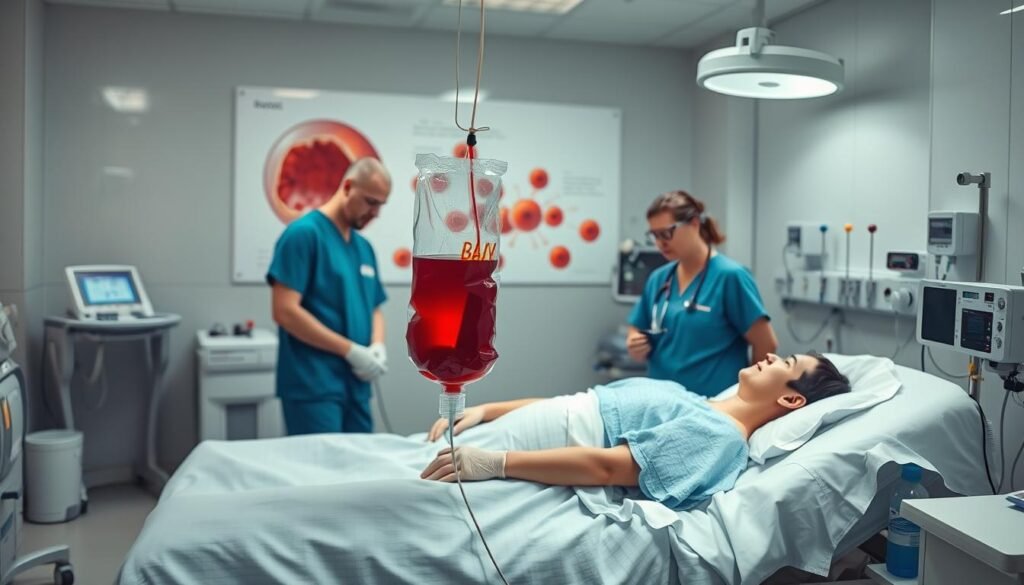Have you ever wondered about the hope for patients with severe anemia? Bone marrow transplantation or stem cell transplant is that hope. It replaces unhealthy bone marrow with healthy cells. This process not only saves lives but also improves the quality of life. Researchers are making great strides in understanding this treatment. The potential benefits for patients’ health and vitality are impressive.
Key Takeaways
- Bone marrow transplantation is essential for restoring healthy blood cell production.
- This lifesaving treatment significantly enhances the quality of life for patients with severe anemia.
- Stem cell transplant procedures can vary based on the patient’s specific condition.
- Understanding the complex process of bone marrow transplantation is vital for prospective patients.
- Research continues to improve the outcomes of bone marrow transplants in treating severe anemia.
Understanding Severe Anemia
Severe anemia means having very low levels of hemoglobin. Hemoglobin helps carry oxygen throughout the body. If it’s low, our bodies struggle to get enough oxygen to tissues. This can cause feelings of tiredness and weakness. It also leads to other health issues. Knowing about severe anemia is key to diagnosing and treating it correctly.
What is Anemia?
Anemia is when you don’t have enough red blood cells. It can happen for many reasons, like not getting enough nutrients, ongoing illnesses, or inherited issues. Symptoms include looking pale, feeling out of breath, and getting dizzy. Finding out the kind of anemia someone has helps doctors figure out the best way to help. Treatments might include different medicines or even a bone marrow transplant.
Types of Severe Anemia
Different kinds of anemia need different treatments. Knowing these types is crucial for helping each person in the best way possible. Here are some common ones:
- Iron-Deficiency Anemia: This happens when you don’t get or absorb enough iron, making you feel tired and weak.
- Aplastic Anemia: A rare kind that occurs when the bone marrow can’t make enough blood cells. It might require a bone marrow transplant.
- Hemolytic Anemia: This type is when red blood cells are destroyed too early. It can be due to autoimmune diseases or genetic issues.
Getting the right diagnosis is important. It helps doctors decide on the best treatment plan. Starting treatment early can really help improve a person’s health.
The Role of Bone Marrow in Blood Cell Production
Bone marrow is crucial in the human body. It is the main place where blood cells are made. This spongy tissue is found inside some bones. It helps turn stem cells into different blood cells. Understanding how bone marrow works is key to knowing its role in our health.
What is Bone Marrow?
Bone marrow is a soft tissue inside our bones. It is vital for our circulatory system, making cells like red and white blood cells, and platelets. If bone marrow is healthy, it can make the blood cells we need for carrying oxygen and fighting infections. But, if it’s damaged, it can cause serious problems like severe anemia.
How Bone Marrow Produces Blood Cells
Blood cell production, or hematopoiesis, starts with stem cells in the marrow. These cells change into specific types of blood cells. Each type has its own job:
- Red blood cells: They carry oxygen all around our bodies.
- White blood cells: They help us fight off infections.
- Platelets: They are important for clotting blood and healing wounds.
In short, bone marrow is vital for making blood cells. It plays a huge role in keeping us healthy. If there’s a problem with the marrow, it might need treatment, such as a bone marrow transplant.
Bone Marrow Transplantation
Bone marrow transplantation is a key treatment for severe anemia and other blood disorders. It aims to swap out damaged or unhealthy bone marrow with healthy stem cells. This helps make new blood cells correctly.
There are two kinds of transplants: autologous transplants use the patient’s own stem cells. allogeneic transplants use stem cells from a donor. Each has its own pros and cons.
The story of bone marrow transplants shows how much they’ve improved. At first, they were not very safe and had a lot of risks. Now, thanks to better tech and knowing more about how bodies fight disease, they are safer and work better.
Before getting this therapy, patients go through many checks. These tests look at health and how bad the blood disorder is. You can find out more about these checks by reading about the stem cell transplant process.
| Type of Transplant | Description | Benefits |
|---|---|---|
| Autologous | Uses the patient’s own stem cells. | Lower risk of graft-versus-host disease. |
| Allogeneic | Uses stem cells from a compatible donor. | Can provide a new immune system to fight disease. |
Bone marrow transplantation is an important breakthrough. It offers new hope for those with severe anemia and other disorders. Many patients now have a chance for a healthier life.
Why Bone Marrow Transplantation is Necessary
Anemia can greatly affect your health, making the body weak and leading to many problems. Chronic fatigue, increased infection risk, and organ damage are some issues caused by not having enough red blood cells. Treatments like iron or blood transfusions might not always work. That’s when a bone marrow transplant becomes critical to improve the patient’s life.
Impact of Severe Anemia on Health
Severe anemia can lead to dangerous health risks. It stops the body from moving oxygen well, which can cause serious problems. Some of these include:
- Fatigue: Feeling tired all the time, which affects what you can do each day.
- Weakness: Not having enough muscle strength.
- Increased Infection Risk: Getting sick more often.
- Organ Dysfunction: Organs not getting the oxygen they need to work properly.
When to Consider a Transplant
Doctors look at several transplant considerations before recommending one. They check things like:
| Criteria | Description |
|---|---|
| Severity of Symptoms | When symptoms get worse and other treatments don’t help. |
| Overall Health | Seeing if the patient is healthy enough for the surgery. |
| Response to Treatment | Looking at how well past treatments worked. |
| Donor Availability | Having a suitable donor makes a transplant possible. |

Types of Bone Marrow Transplants
Bone marrow transplants are key for patients with severe anemia. Knowing the different types of bone marrow transplants is critical. Each type comes with its own set of benefits and things to think about. These aspects play a big role in how well patients do after the procedure.
Autologous Transplant
An autologous transplant uses the patient’s own stem cells. These are taken out and kept safe before starting treatment. This method cuts down on the chance that the body will reject the cells. It sees them as its own.
Before the transplant, patients get special therapy. This therapy helps get rid of sick cells and makes a good place for the new cells to grow. But, this way of doing things needs a lot of planning. It’s to make sure enough cells are collected for the transplant.
Allogeneic Transplant
The allogeneic transplant needs stem cells from a donor who’s a good genetic match. Finding the right match is vital for success. This kind of transplant can give a stronger immune reaction. It could lead to better results for those fighting serious illnesses.
Finding a donor can be hard, though. This shows why systems for matching donors are so important. The choice of transplant often comes down to the patient’s specific illness and their overall health.
Looking into types of bone marrow transplants offers more insight. It helps improve care and planning for treatments.
The Bone Marrow Transplant Process
The bone marrow transplant journey involves several critical steps. It starts with a pre-transplant evaluation. This vital assessment checks the patient’s overall health, making sure they’re ready for the procedure. After this review, the transplant takes place, a key step in treating severe anemia.
Pre-Transplant Evaluation
The pre-transplant evaluation is detailed. It includes tests and talks with doctors. They look at the patient’s health, how well organs work, and disease-related conditions. This stage is key for spotting risks and checking if the patient can undergo the transplant.
- Blood tests to evaluate cell counts and organ function
- Imaging studies to assess overall health
- Evaluations by specialists, including cardiologists and pulmonologists
- Psychological assessments to ensure emotional readiness
Transplant Procedure Overview
The actual transplant is crucial in the bone marrow transplant process. First, conditioning therapy is done, which can include chemo or radiation. This gets the body ready for new stem cells. Then, healthy stem cells from a donor go into the patient’s bloodstream. Here, they start to make new blood cells.

| Step | Description | Purpose |
|---|---|---|
| 1. Pre-Transplant Evaluation | A series of tests and consultations | Determine eligibility and assess risks |
| 2. Conditioning Therapy | Chemotherapy or radiation treatment | Prepare the body for transplantation |
| 3. Stem Cell Infusion | Infusing healthy stem cells | Generate new blood cells |
It’s important for patients and their families to understand this whole process. It helps them deal with the treatment and recovery of a bone marrow transplant.
Finding a Donor Match
Finding the right donor match for a bone marrow transplant is very important. It plays a big part in the success of the treatment. If the donor and recipient don’t match well, there could be serious health problems. We will look at how doctors decide if a donor matches and the steps to find one.
The Importance of Compatibility
For a bone marrow transplant to work well, the donor and recipient must be a good match. Doctors use something called the human leukocyte antigen (HLA) system to check this. The HLA system deals with the proteins on cells that help with immune responses. A good match means a lower chance of the body rejecting the transplant. Studies show that matching donors with recipients leads to better survival chances. This shows how important compatibility is.
How to Search for a Donor
To find a donor, people must sign up with bone marrow registries. One key organization for this is Be the Match. It helps connect patients with people who could be good donors. The search looks at registries in your country and others because finding a genetic match can be tough. This is especially true for people with diverse ethnic backgrounds. That’s why it’s necessary to look as widely as possible for a donor.
| Steps in the Donor Search Process | Description |
|---|---|
| 1. Registration | Patients register with a bone marrow registry to begin the matching process. |
| 2. HLA Typing | Potential donors undergo testing to determine their HLA type, which is essential for matching. |
| 3. Matching | The registry searches for donors who have a compatible HLA type. |
| 4. Contact | If a match is found, both the donor and recipient undergo further evaluations. |
| 5. Donation | Once cleared, the donor proceeds with the donation process, contributing to the patient’s treatment. |
Post-Transplant Care
After a transplant, patients start a key journey to recovery. This involves health checks and help in rehabilitation. It’s very important to find and deal with any issues early on.
Monitoring Health After Transplant
Keeping an eye on health is crucial post-transplant. Patients need to check in regularly for signs of trouble like infections or graft-versus-host disease (GVHD). A nurse who knows transplant care well leads these check-ups. They watch closely for bad effects from the transplant.
Watching for symptoms helps patients recover more successfully.
Rehabilitation and Support
Rehabilitation helps patients get back their strength and normal activities. Each patient gets a rehab program made just for them. This program includes counseling, joining support groups, and learning ways to handle stress.
Feeling emotionally strong is very important after a transplant. There are many programs to help patients adjust to life after their transplant. For more info, visit post-transplant guidance for advice on diet and other treatment approaches.

Potential Complications of Bone Marrow Transplantation
Bone marrow transplantation can save lives. However, it’s crucial to know about possible complications. This knowledge helps patients and caregivers deal with recovery challenges.
Graft-Versus-Host Disease
A major risk is graft-versus-host disease (GVHD). It occurs when the transplanted immune cells see the recipient’s body as foreign. This can be mild to severe and affect the skin, liver, and gut.
Spotting GVHD early is key to managing it. This leads to better recovery outcomes.
Other Common Complications
Along with GVHD, patients might face other issues after the transplant. Infections are a big risk because of the drugs that suppress the immune system. Other complications include:
- Bleeding disorders caused by lowered platelet counts
- Organ damage resulting from conditioning therapy before transplant
- Graft failure, where the transplanted cells do not function as intended
By keeping a close watch and acting quickly, patients can better manage these complications. This helps in making the recovery smoother.
| Type of Complication | Description | Management Strategies |
|---|---|---|
| Graft-Versus-Host Disease | Immune cells attack the recipient’s tissues | Immunosuppressive medications |
| Infection | Increased risk due to weakened immune system | Prophylactic antibiotics and vaccinations |
| Bleeding Disorders | Low platelet counts can lead to significant bleeding | Platelet transfusions and monitoring |
| Organ Damage | Potential damage from pre-transplant conditioning | Regular monitoring and supportive therapies |
Living with Severe Anemia after Transplant
After a bone marrow transplant, new challenges await, especially for those recovering from severe anemia. It’s crucial to focus on long-term health. This means regular doctor visits, watching for complications, and making lifestyle changes to support blood health. Taking these steps helps avoid problems and improves well-being.
Long-Term Health Considerations
Starting life with anemia after a transplant means keeping up with healthcare is key. Setting up a routine with regular check-ups helps spot any issues early. Also, eating well and staying active boost hemoglobin and energy. Learning more about managing anemia is helpful, as studies on ABO blood group incompatibility post-transplant show.
Emotional and Psychological Support
Feeling good emotionally is essential during recovery. Adjusting to everyday life might seem hard, and strong support networks are crucial. Support can come from community resources, groups, or mental health experts focused on transplant care. These groups are key in building strength, dealing with anxiety or depression, and finding ways to adapt after treatment for severe anemia.